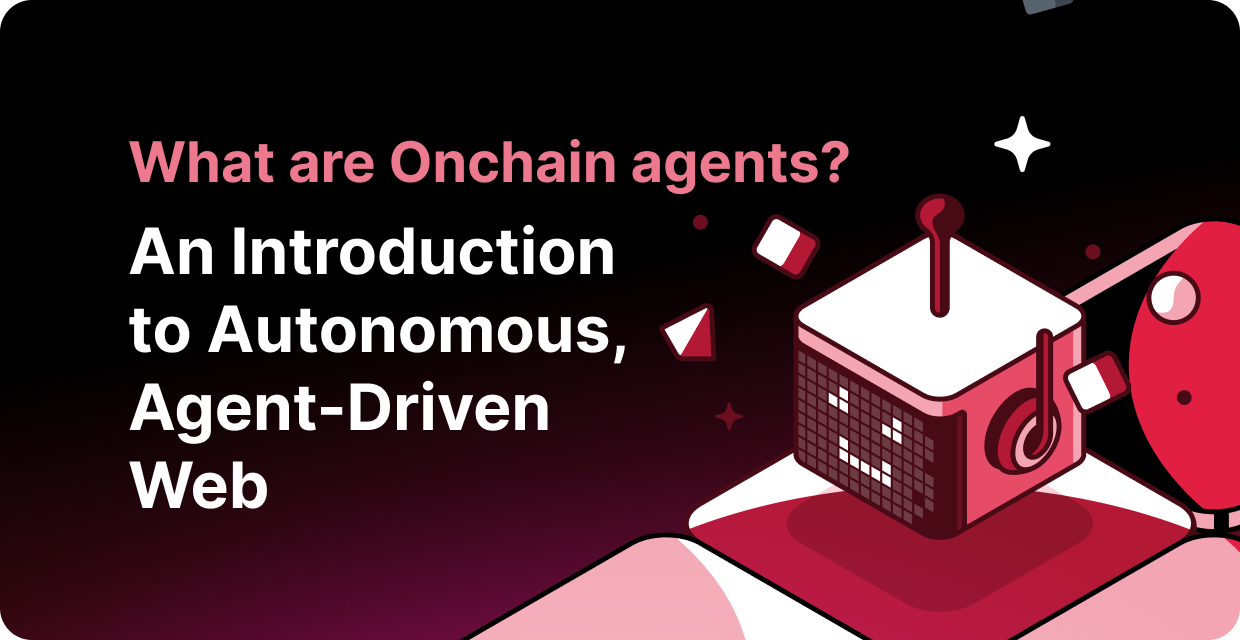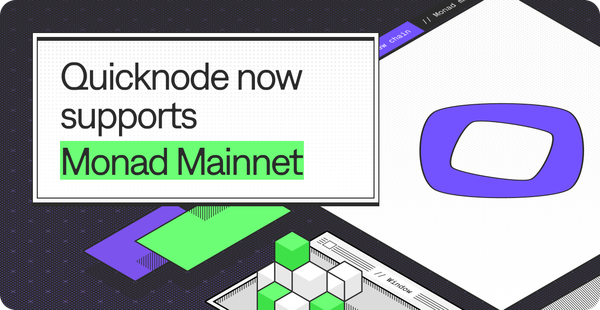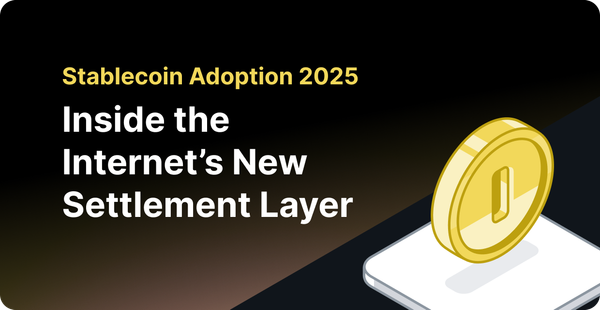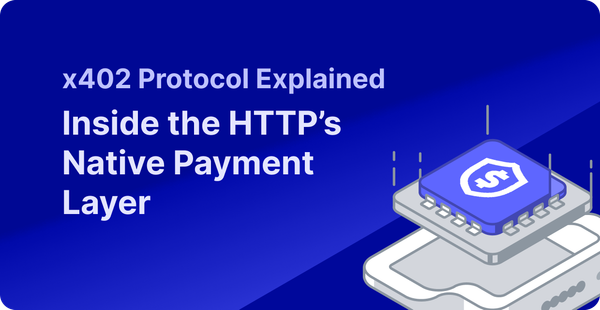What are Onchain Agents? An Introduction to Autonomous, Agent-Driven Web
An introduction to onchain AI agents: autonomous programs that combine blockchain trustlessness with AI intelligence. Learn how they work.

The lines between artificial intelligence and blockchain technology are blurring.
As a developer in 2025, you've likely experimented with both — perhaps building smart contracts one day and fine-tuning LLMs the next. But there's a fascinating convergence happening: AI agents are moving onchain, promising to bring autonomous, verifiable intelligence to decentralized systems.
Think of onchain AI agents as digital entities that combine the trustless properties of blockchain with the cognitive capabilities of AI models. They can interact with smart contracts, process information from oracles, and make decisions based on real-time blockchain data — all while maintaining the transparency and immutability.
Let's dive into what makes these agents tick, how they work, and learn some challenges that developers face currently while deploying AI agents onchain.
What Are Onchain AI Agents?
Onchain AI agents are autonomous programs that live and operate directly on blockchains. They monitor blockchain state, process data through AI models, and take actions based on programmed objectives — all without human intervention once deployed.
Ex: An agent might be responsible for rebalancing a DeFi position, managing a validator node, or even optimizing gas costs.
The Agent Trinity: Wallet + Logic + Intent
Every functional onchain agent is built on three fundamental components:
- Wallet: The agent's blockchain identity and economic interface to manage assets, pay gas fees, and execute transactions. Advanced agents often use smart contract wallets or account abstraction for complex operations like batched transactions, gasless operations, or multi-signature security models.
- Logic: The decision-making engine that processes information and determines actions. This can range from simple rule-based systems ("if token price drops 10%, sell position") to sophisticated AI models that analyze market sentiment, technical indicators, and on-chain metrics simultaneously.
- Intent: The programmed objectives and constraints that guide agent behavior. Intent defines what the agent is trying to achieve — whether that's maximizing yield in a DeFi position, maintaining protocol health, or facilitating cross-chain asset transfers.
Onchain agents represent a commitment to transparency, verifiability, and decentralized operation that aligns with the broader vision of trustless systems.
As the infrastructure matures, developers increasingly require the tools to build agents that don't compromise on either intelligence or decentralization.
Notable Frameworks Powering Onchain AI Agents
As the agent economy takes shape, a growing ecosystem of frameworks is making it easier for developers to build, deploy, and manage onchain AI agents. These frameworks abstract away the complexities like intent encoding and execution environments, allowing developers to focus on agent behavior and logic.
AgentKit by Coinbase
AgentKit is a developer toolkit designed to simplify the creation and orchestration of onchain agents. It enables agents to encode user intent, reason about blockchain state, and interact with smart contracts through a structured execution flow. Key features include:
- Intent Encoding: A standardized way to describe agent goals and constraints.
- Wallet Abstractions: Native support for smart contract wallets and account abstraction patterns.
- Composable Actions: Agents can chain and batch actions across multiple protocols.
- Secure Execution: Verifiable execution pathways that preserve trustlessness.
Virtuals Protocol
Virtuals Protocol takes a unique approach by focusing on AI-native agents with autonomous economic behavior. The framework is designed around the concept of "Virtual Beings" — AI agents that can own assets, participate in governance, and generate revenue through their activities.
The protocol's strength lies in its tokenization model, where agents themselves become investable assets. This creates novel economic incentives where agent performance directly impacts token value, aligning developer interests with agent optimization.
The framework includes sophisticated reputation systems and performance tracking, making it ideal for agents that need to build long-term trust and credibility.
ElizaOS
ElizaOS positions itself as the operating system for autonomous agents, providing a comprehensive runtime environment for multi-modal AI agents. The framework emphasizes modularity and composability, allowing developers to build agents that can seamlessly interact with multiple blockchains, AI models, and external APIs.
Key features include,
- A plugin architecture for extending agent capabilities,
- Built-in memory management for maintaining context across interactions, and
- Standardized interfaces for common blockchain operations.
ElizaOS agents can handle text, voice, and visual inputs, making them suitable for complex user-facing applications. The framework's strength is in building sophisticated conversational agents that can execute blockchain transactions based on natural language instructions while maintaining context and user preferences.
GOAT Framework
The GOAT (Generative Onchain Agent Toolkit) framework focuses on simplicity and rapid prototyping. It provides a minimal but powerful set of abstractions for building agents that can interact with any EVM-compatible blockchain.
GOAT's philosophy centers on developer experience: the framework can get simple agents up and running in minutes while being scalable.
The framework particularly shines for developers new to onchain agents, offering extensive documentation, example implementations, and a growing library of community-contributed agent templates.
ZerePY
ZerePY takes a Python-first approach to agent development, recognizing that many AI developers are most comfortable in the Python ecosystem. The framework provides seamless integration between popular Python AI libraries and blockchain networks.
The framework's key innovation is its ability to run Python-based AI models directly in agent decision loops while maintaining secure key management and transaction execution. ZerePY includes built-in support for popular ML frameworks like PyTorch and transformers, making it easy to deploy sophisticated AI models.
ZerePY particularly excels for agents that require complex data analysis, machine learning inference, or integration with existing Python-based AI workflows.
Choosing the Right Framework
Each framework serves different use cases and developer preferences.
- AgentKit suits teams building production applications requiring enterprise reliability.
- Virtuals Protocol works well for creators building economically-driven AI agents.
- ElizaOS fits projects needing sophisticated multi-modal capabilities.
- GOAT Framework serves developers wanting rapid prototyping and simple deployment.
- ZerePY appeals to Python-native AI teams.
The choice often depends on the specific agent requirements, team expertise, and long-term maintenance considerations. Many developers start with simpler frameworks like GOAT or ZerePY for prototyping before migrating to more comprehensive solutions as their agents mature.
With frameworks making agent development increasingly accessible, the question isn't whether onchain agents will proliferate — it's how fundamentally they'll reshape blockchain interactions and digital economies.
Why Onchain Agents Matter for the Future
Onchain agents introduce a new paradigm for how decentralized systems operate — one where automation doesn't come at the cost of centralization. Unlike traditional bots or cloud-based scripts, these agents function within trustless environments, executing actions that are transparent, verifiable, and subject to protocol-level constraints.
Automation without Centralization
Onchain agents solve web3's automation problem without introducing trusted intermediaries. Unlike traditional bots that run on centralized servers, these agents operate directly on blockchain networks, executing complex strategies while remaining transparent and verifiable.
Users gain 24/7 portfolio optimization, automated yield farming, and intelligent transaction timing without sacrificing the trustless properties that make decentralized systems valuable.
The result is dramatically improved user experience without compromising on decentralization principles.
Composable Intelligence
The real power emerges when agents collaborate. Specialized agents can discover and coordinate with each other through standardized blockchain interfaces, creating emergent intelligence that exceeds individual capabilities.
A portfolio management agent might work with market analysis agents, risk assessment agents, and execution agents to implement sophisticated strategies.
This composability enables complex multi-protocol operations and cross-chain strategies to be orchestrated seamlessly, making advanced DeFi accessible to everyday users.
From Users to Networks of Agents
Blockchain applications are evolving from serving individual users to coordinating networks of autonomous agents. Instead of humans manually triggering transactions, agents represent users, protocols, and AI systems in an autonomous economy.
Protocols become self-regulating through agent networks that monitor health, adjust parameters, and coordinate upgrades. This creates living ecosystems where agents continuously optimize performance and discover opportunities, fundamentally transforming how decentralized systems operate and evolve.
The result is a more fluid, intelligent, and autonomous internet, powered by agents, secured by blockchains, and enabled by platforms like QuickNode.
The Rise of the Agentic Web is Inevitable
Onchain agents represent the next evolution of blockchain technology — where autonomous intelligence meets decentralized infrastructure.
As frameworks like AgentKit mature and infrastructure providers like QuickNode make reliable, scalable access seamless, the foundation is being laid for an intelligent, agent-driven web3. The future belongs to developers who can harness both AI capabilities and blockchain reliability to create truly autonomous decentralized systems.
The agent economy is only just beginning.
What are the benefits of deploying agents onchain rather than offchain?
Onchain deployment ensures transparency, verifiability, and decentralization. It removes reliance on centralized servers or third parties, enabling trustless automation within Web3 ecosystems.
Which framework should I use to build my first onchain agent?
For rapid prototyping, GOAT or ZerePY offer simplicity and strong documentation. For production-ready builds, AgentKit provides structured intent encoding and reliable infrastructure, especially when paired with QuickNode.
Do I need to be an AI expert to build onchain agents?
Not necessarily. Frameworks like GOAT and AgentKit provide templates and abstractions that let developers build effective agents with basic programming skills. However, sophisticated agents using machine learning models or natural language processing will benefit from AI/ML knowledge.
About QuickNode
QuickNode provides the tools and resources builders need to create incredible products. With a globally balanced infrastructure, guaranteed reliability, a user-friendly interface, and end-to-end customer support, QuickNode allows enterprises to realize their ideas on the chain rapidly.






